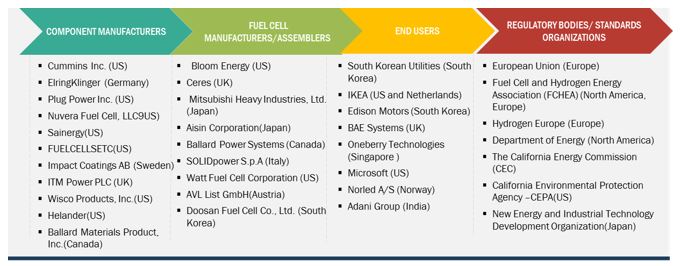Fuel Cell Market New Revenue Pockets:
The global fuel cell market size is estimated to be USD 2.9 billion in 2022 and projected to reach USD 9.1 billion by 2027, at a CAGR of 26.0%. Stringent emission norms across the globe is a driving factor for the market growth. Moreover, increase adoption of clean and green technologies in public and private transport to boost the market in near future.
Download PDF Brochure: https://www.marketsandmarkets.com/pdfdownloadNew.asp?id=348
Increasing urge for cleaner transportation system by various government is contributing to the development of fuel cell for transportation purposes. Currently PEMFC is majorly employed for transportation application as it has a advantage of operating in low temperature. Major focus is shifting toward marine transportation. Fuel cell can be a good option as it is easy to carry liquid electrolyte than hydrogen in a marine vessel. Also railway locomotives are gaining attraction in European countries based on fuel cell technologies. Japan is already using fuel cell based public transport and has pledged to increase the use of fuel cells. Additionaly, the rise in the development of hydrogen refueling stations is supporting the adoption of fuel cells. Major automobile manufacturers like as Honda (Japan), Toyota (Japan), and Nissan (Japan) are forming joint agreements with gas companies to develop a 100-station hydrogen highway within Japan.

SOFC segment is the fasted growing segment by fuel cell type in the forecast period from 2022-2027. Companies like Cummins Inc. (US), Robert Bosch GmbH (Germany), WEICHAI POWER CO., LTD. (China), Doosan Fuel Cell Co., Ltd. (South Korea), FuelCell Energy (US), Posco Energy (South Korea), and Clara Venture Labs (Norway) are extensively developing SOFC technology for mass production. Moreover, SOFC’s utilization for combined heat & power applications in industries is gaining momentum and is expected to drive the market growth of this segment.
Commerical & Industrial segment is the fastest growing segment by fuel cell end user in the forecast period. Countries like Japan has made it mandatory for commercial sectors, power generators to reduce their carbon footprint either by adopting the renewable and green technologies or by purchasing the carbon credit. Hence, adoption of fuel cells in malls, hospitals, office buildings, sports centers can result in reliable electricity, decarbonisation, and long term cost savings.
Request Sample Pages: https://www.marketsandmarkets.com/requestsampleNew.asp?id=348
As adoption of fuel cells rise in data centers, space programs, hydrogen refueling statoons, and distributed power generation, major players have an extensive end user pool to grow their busineses. As more and more governments are issuing decarbonisation mandates, major players can tap into these initatives and grow their fuel cell businesses. Governments are also offering grants to conduct research in fuel cells for making them more cost effective & efficient, which opens up an opportunity for major players to accelerate their growth.


